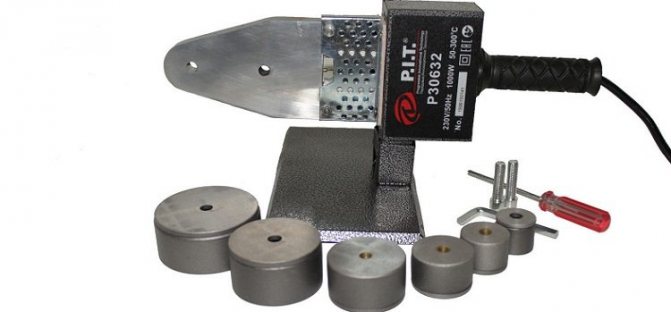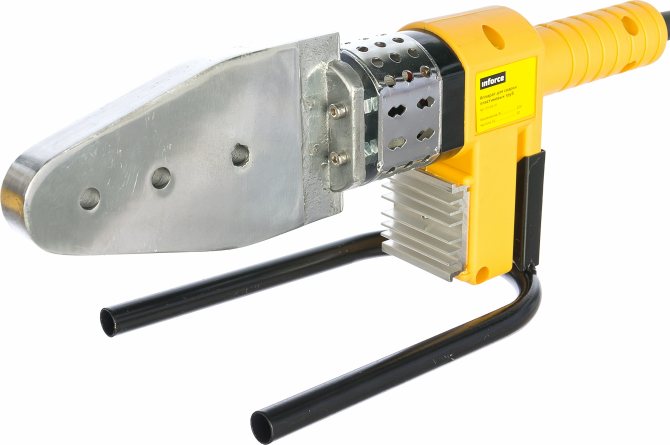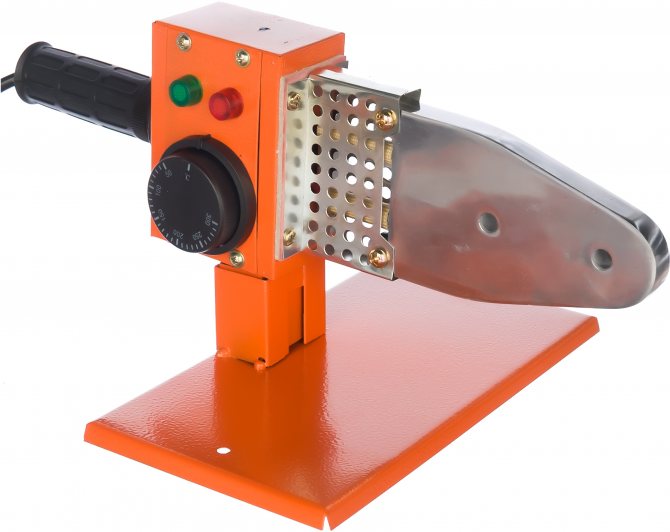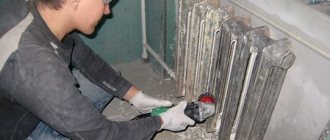How to make a soldering iron for polypropylene pipes
It so happens that it is urgently necessary to solder two polypropylene pipes, and there is no soldering iron at hand for welding. What should be done in this case? Is there a way out of this situation?
In fact, even if your old machine for welding polypropylene pipes is out of order and cannot be repaired, there is a way out of the situation. In any case, you should have left the Teflon-coated soldering iron tips. So, using them, you can easily make a soldering iron for polypropylene pipes with your own hands.
How, and from what it can be made, will be described in this article of the construction magazine.
Soldering iron for plastic pipes: how to buy a quality product
The main task of such a soldering iron is to maintain the required temperature for connecting a polypropylene pipe with a fitting, and its heating temperature is about 260 degrees.

According to buyers, choosing a soldering iron should be selected according to 3 criteria:
- The shape of the heating element;
- Thermal power;
- The price of the device.
- In terms of cost, soldering irons can be divided into 3 groups:
- Russian and Chinese-made soldering irons are cheaper;
- The average cost will most often have Turkish-made soldering irons;
- Expensive soldering irons will be models from European manufacturers, and German and Czech soldering irons will become popular among them.
A soldering iron for plastic pipes from a Chinese manufacturer is suitable for soldering a home heating system. Experts say that such a soldering iron will definitely be enough for two systems, and this is quite enough for the first job of a person who has decided to make heating using polypropylene pipes, and you can even give it to someone else to use it.
Do not use Chinese-made soldering irons for commercial orders. The whole reason is not that it is not of high quality, but that it is not able to maintain an accurate temperature. The error in cheap spikes reaches 10 degrees and higher, and this contributes to a poor-quality connection, and you cannot visually check this. Defects of this kind are not acceptable when ordering.
For beginners, a Turkish-made pipe soldering iron is more suitable. The error of Turkish soldering irons is very small and the reliability of such a soldering iron is excellent. The medium-sized cost makes Turkish-made soldering irons popular even in firms that are engaged in the installation of heating from plastic pipes. In order to save money, firms assure that it is more profitable to purchase 3 Turkish soldering irons than one German or Czech one. Craftsmen who have been engaged in the type of such work for more than one year know that the Czech and German soldering iron will serve for a long time and will ensure the quality of soldering.
Soldering iron tips
When visiting an online store or a retail network, we seek help from a consultant who will help you choose equipment for connecting polypropylene structures of a pipeline system. As a rule, specialists in the trading network know only the basics of products, and it is not always possible to take the consultant's word for it. It is enough to turn to the Internet, where the consumer can read reviews and detailed technical characteristics of the equipment, and even for himself to make a rating of the best companies of soldering irons for polypropylene pipes. Each manufacturer has its own secrets and is ready to offer the consumer the best product in his opinion.
Typical equipment designs have a mandatory heating component and holders, which in turn are placed inside the soldering iron structure. The holder, regardless of the manufacturer, must be thermally insulated and maintain its position in one direction during technological operations. The heating part of the equipment should be responsible for the general principle of melting and ensure efficient operation of joining dissimilar parts of polypropylene materials intended for the installation of a pipeline system.
Self-made soldering iron for polypropylene pipes
The job of a soldering iron is to stick pipes that have been heated to the desired temperature. It is not always necessary to re-solder or repair half of the wiring of heating and water supply systems in the house. It often becomes necessary to work to replace two or three connections. And in this case, it is not necessary to buy a soldering iron, but you can make it yourself.


For an electrician who has plumbing skills, the manufacture of such a soldering iron will take a couple of hours.
Most often, water pipes are hidden from view, for this they are smoothed into canals and therefore you should not worry about beauty and aesthetics. But this is not important, it is important to incorrectly adjust the heating temperature and overheating of pipes or fittings, even if the overheating is not many degrees, it will lead to rejection. In such a soldering, the main issue is the quality of the soldering of the parts. If, when performing soldering with a home-made soldering iron, a slight discrepancy in the appearance of the elements to be soldered is allowed, then when using a purchased soldering iron everything should be perfect.
To make a soldering iron for propylene pipes with your own hands, you will need such materials:
- A heating element;
- Required fitting for your pipe size and soldering iron nozzle;
- Nickel-plated bolts and nuts M8, they will serve for attaching nozzles to the heater;
- Thermocouple based;
- Mounting for secure fixing of the soldering iron to the auxiliary surface.
In addition to temperature, the power and heating rate of the pipe surface for the connection are also very important. If the heating of the connecting elements is long, then the parts that heat up lose their shape and geometric dimensions.
It is for this reason that the material should have a diameter of 15 to 30 millimeters, and the capacity of the apparatus from 700 to 900 units. need This power corresponds to the heating of the iron.
The scheme of work for plumbing is very simple, you need an outlet, a curling iron, a PVC pipe, which must be pre-cleaned and, of course, the desire of the master. The whole work will not take much time, because it is not difficult.
Tips and tricks: how to choose a soldering iron for polypropylene pipes
Having determined the shape of the heating platform, we proceed to the selection of technical parameters. One of the first and most important is to choose the power. When choosing the power, you should not choose the largest, if more, it does not mean which is better. Since powerful soldering irons are designed for brazing large diameter pipes. If you need to solder pipes, the size of which is about 50 mm, that is, this is a standard heating system, then a soldering iron with a power of 600-800 W is suitable for such purposes. In general, the packaging indicates the number of nozzles and the diameter for which they are intended. You can navigate by such instructions.


It is important to note the thermostat, how accurately it is configured, how long it keeps the temperature, because the quality of soldering depends on this. This is especially true for beginners.
In the absence of experience and practice in this type of work it is worth it, it is based on norms and standards.
And that is why it is necessary to choose a soldering iron for pipes with a smooth temperature setting and study the instructions for using the soldering iron before work. Moreover, you need to study not only the instructions for using the soldering iron, but also the pipes and accessories you bought where not only the component of the pipes and other things is written, but also the optimal temperature for soldering is indicated. Then we set the required temperature on your soldering iron. If not, there are no instructions, then you can use the average holding time, but before starting soldering, you need to try your hand at pipe sections and more than once.
When testing on pipe lengths, you will also understand sufficient warm-up time or whether you need to add or decrease. These pipes are not expensive, so they can be purchased with a margin for training. You also need to pay attention to the attachments. The nozzles must be covered with Teflon, because of the Teflon coating, heated elements of polypropylene pipes are very easy to remove. A high-quality coating should have a bluish-green color.
For propylene welding, it is better to choose an apparatus whose rating is trustworthy. So, for example, an electric soldering iron, which is produced in Turkey, has excellent quality. Turkish polypropylene electric soldering iron is a good choice if you need a professional approach and a reliable device. Plus, it looks like a blow gun and will catch the attention of your employers. If you are going to work with PPR once, then you can purchase Russian brands. A soldering tool can be provided by a plumbing store called Castorama or Stavr. In addition, you can buy such a product at the OLH, where you can find out its full full review and view photos.
Soldering iron nozzles for polypropylene pipes
The minimum number of nozzles should be 3, they are the most popular, and their diameter is 20, 25 and 32 millimeters. But after a certain period of use, the attachments supplied with the kit will wear out and must be replaced.
The tips have a cylindrical shape made of aluminum alloy or copper, which are coated with a non-stick Teflon layer. When buying baits, pay your attention to the quality of the layer, and do not save too much on this.


The coating layer depends on the cost of the nozzle, that is, the smaller the layer, the lower the price and service life of the expensive one.
Wear of the nozzle manifests itself in such a way: the appearance of smoke, plastic residues on the nozzle, adhesion of parts and the occurrence of difficulties when removing pipes.
How to use a polypropylene pipe iron
The process of connecting pipes itself is very simple and therefore attracts many home craftsmen.
The work must be carried out in the following sequence:
- We prepare the pipe for soldering in this way: it must be cut evenly and cleaned, and if necessary, remove the foil layer;
- We turn on the soldering iron and set the temperature;
- After the soldering iron is heated to the temperature you selected, this will be indicated by a light indicator, we put on the pipe and fitting from different sides on the necessary nozzles;
- We hold the specified time without delay and carefully remove the parts from the soldering iron;
- We connect the pipe to the fitting without rotation and the whole connection is ready.
The time that must be maintained depends on the diameter of the pipe.
Butt welding
Pipes with the same diameter
This technology is designed to connect pipes of the same type, with the same diameter. It is very important to ensure strict alignment of the mating parts and to prepare the ends well for a perfect initial adhesion of the surfaces.
For installation work, you will need a pipe cutter. More information about pipe cutters for polypropylene pipes can be found in this article
Then, both ends of the mating pipes are simultaneously heated so that they melt to the required depth over the entire cross-sectional area.
Then comes the stage of compression of the mating parts - this is achieved due to mechanical force, with opposite vectors that are directed strictly along the axis of the pipe. Ultimately, a diffusion effect is observed in the polypropylene melting section, i.e. mutual penetration of the polymer. Next comes the required technological pause to ensure complete polymerization and obtain a monolithic compound.
Complete polymerization process
The technology itself is rather laborious. As already mentioned, it is very important that the ends are well processed, that they are located on the same axis and the amount of force applied must be strictly observed. It is very difficult to comply with all these conditions without using an apparatus for welding polypropylene pipes.
At home, butt welding is rarely used! Usually it is more in demand in a professional environment.



























